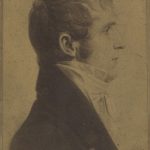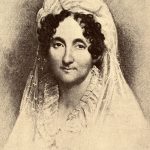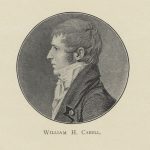William H. Cabell (1772-1853)
 The firstborn of Col. and Mrs. Nicholas Cabell, William H. Cabell was the only member of the Cabell family to serve as Governor of the State of Virginia. Following a thorough education, including private tutors, four years at Hampden Sydney College (1785-1789), three years at the College of William and Mary (1790-1793), and a year of legal training in Richmond (1793-1794), he followed his father’s footsteps by entering public service at a young age.
The firstborn of Col. and Mrs. Nicholas Cabell, William H. Cabell was the only member of the Cabell family to serve as Governor of the State of Virginia. Following a thorough education, including private tutors, four years at Hampden Sydney College (1785-1789), three years at the College of William and Mary (1790-1793), and a year of legal training in Richmond (1793-1794), he followed his father’s footsteps by entering public service at a young age.
In 1795, Cabell married his first cousin, Elizabeth Cabell, and moved into “Union Hill,” the Amherst County home of his uncle, Col. William Cabell. The presence of three “William Cabells” in the same household prompted Cabell, christened simply William Cabell, to add the middle initial “H.” to his name in order to distinguish him from his kinsmen. The residents of Amherst county took a liking to “William H. Cabell” and elected the twenty-three year old to the House of Delegates just over a year after his marriage. He was returned to the House again in 1798.
 The death of Cabell’s first wife in 1801 did not impair his popularity in the county, and he won election each year from 1802-1805. In 1805 he remarried, to Agnes S. B. Gamble (1783-1863), and declined to serve his county as their representative. More prestigious duties awaited Cabell and his new bride (shown at right), for his colleagues in the General Assembly had selected him as Governor.
The death of Cabell’s first wife in 1801 did not impair his popularity in the county, and he won election each year from 1802-1805. In 1805 he remarried, to Agnes S. B. Gamble (1783-1863), and declined to serve his county as their representative. More prestigious duties awaited Cabell and his new bride (shown at right), for his colleagues in the General Assembly had selected him as Governor.
While leading Virginia, Gov. Cabell worked closely with the administration of then President Thomas Jefferson. When Aaron Burr organized a rebellion in the trans-Appalachian West in 1804, Cabell helped the administration quell the threat. In January 1807, the Virginia governor called up several units of the militia to crush the insurrection. Once Burr was arrested, on February 20, Cabell then oversaw his transfer to Richmond, where he was scandalously acquitted of all charges before the Circuit Court of the United States for the District of Virginia.
During Burr’s trial, on June 22, the HMS Leopard fired on the USS Chesapeake when Commodore James Barron refused to allow the British vessel to board his ship in search of deserters. The event occurred just off the Virginia capes, and Gov. Cabell reacted with passion and energy to this affront to America’s rights as a neutral in the contest between Britain and France. To the General Assembly, he fumed that the assault was “an outrage unprecedented in the history of nations” and dispatched troops to the Chesapeake Bay to defend against possible invasion and to prepare to fire upon British vessels should Congress declare war. Jefferson avoided war and pushed instead for passage of the infamous Embargo Act of 1807.
Cabell completed his term as Governor in 1808 and immediately took on new responsibilities as a Judge of the General Court. He also purchased a home in Buckingham County from his cousin Joseph “Repton Joe” Cabell (1762-1831) around 1810, and named the estate “Montevideo.” While Agnes Cabell and his growing family spent most of their time at Montevideo, Cabell himself was increasingly at Richmond, especially following his appointment in 1811 to the Court of Appeals. The separation eventually became too constant and too great a strain, so Cabell sold Montevideo in 1822 and brought the family to Richmond. One constant in Cabell’s peripatetic life as politician, judge, landowner, and member of an influential and wealthy extended family was the relationship between Virginia’s massive population of enslaved African Americans and the whites who controlled their existence: there were laws concerning the enslaved to enact and enforce; lawsuits over human property to adjudicate; his various estates to run using the labor of the many enslaved persons he kept on them; his responsibilities to care for the basic needs of the enslaved persons he owned; and the myriad business decisions to be made in inheriting, buying, selling, and managing the enslaved.
Cabell served on the Court of Appeals for four decades, including nine years (1842-1851) as president of that body. During this time, he joined Spencer Roane (1762-1822) in the defense of State’s Rights through the courts. Cabell and Roane fought as “Old Republicans” against the federal government in the famous case Martin v. Hunter’s Lessee (1816). Pursuant to the Judiciary Act of 1789, the federal government claimed appellate jurisdiction over disputes over state law, while Cabell and Roane insisted that each state’s highest court should be the highest judge of state law. The Old Republicans lost the battle, and Cabell continued to serve on the court with integrity and diligence until his retirement in 1851. He died in Richmond two years later.
Additional Sources Consulted:
Edwin M. Gaines, “The Political Career of Governor William H. Cabell” (1954)
Thornton F. Miller, Juris and Judges Versus the Law (1994)
Henry C. Riely, Sketch of William H. Cabell (1930)
Margaret V. Smith, Virginia, 1492-1892 (1893)

